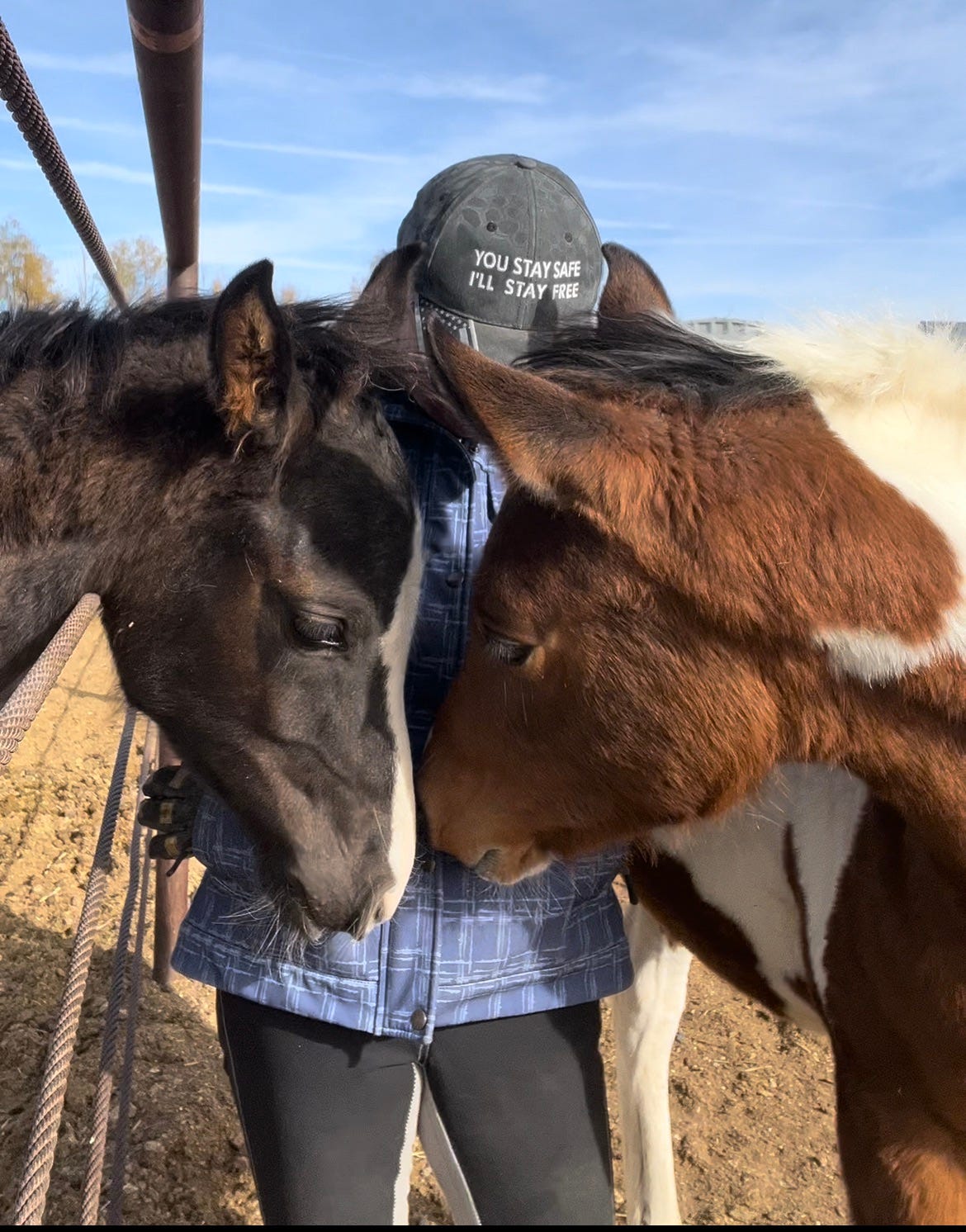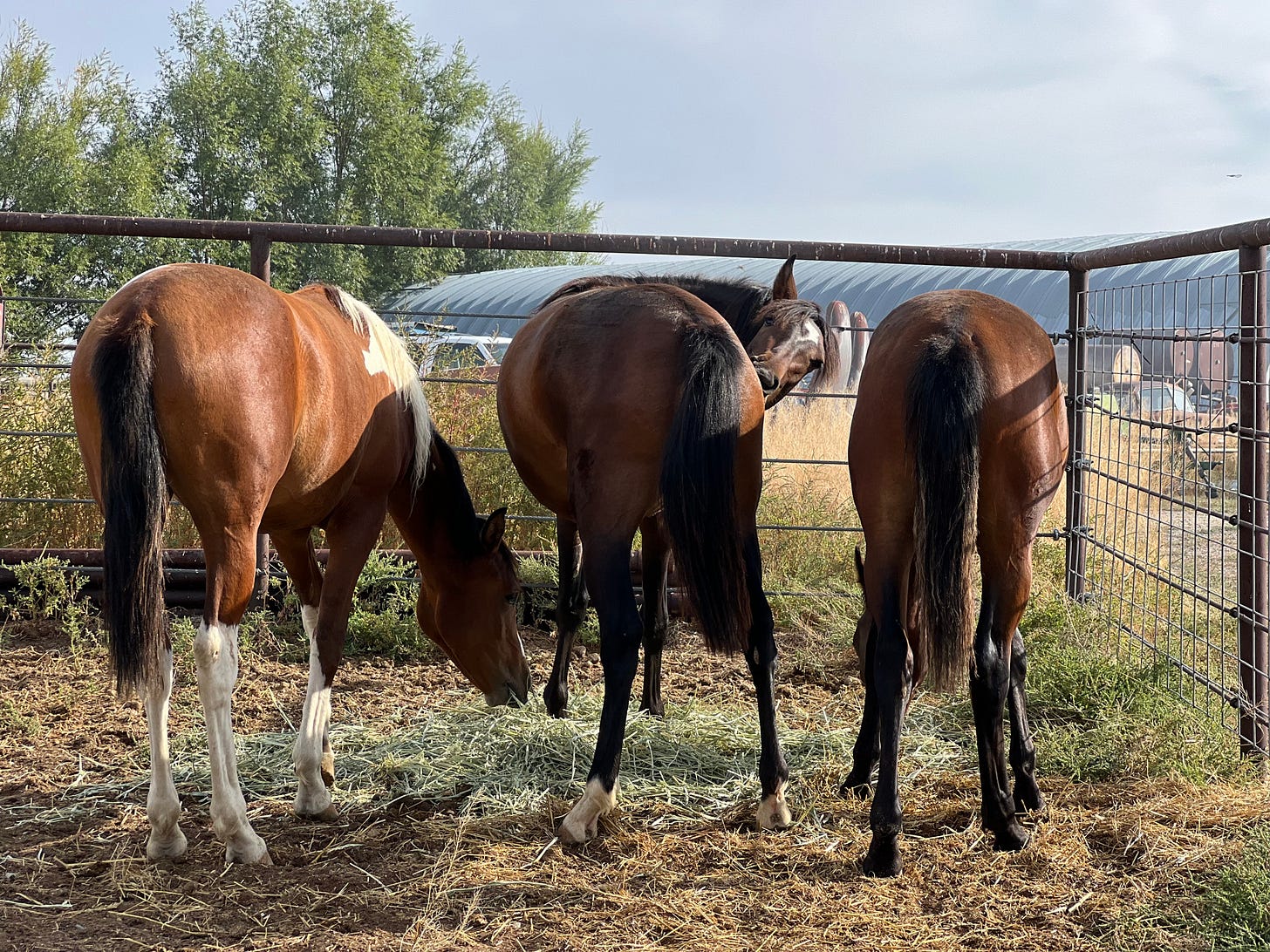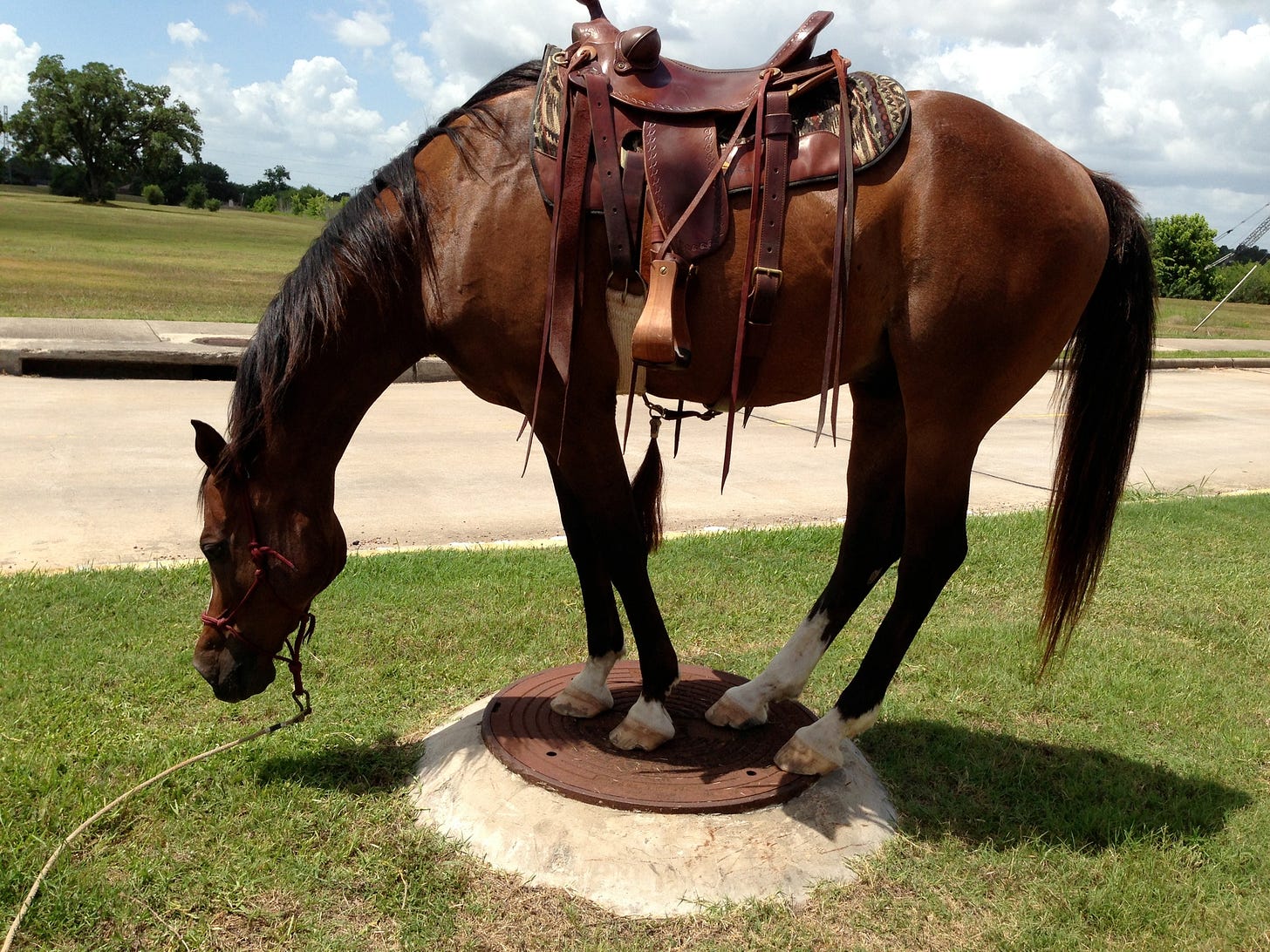Our foals learn early on that we are two-legged members of their herd. Learning to speak horse is what makes this possible.
People often get caught in the trap of micromanaging their horses. Commonly without realizing it, they allow horses to become dull to requests, leading to greater and greater frustration. These horses never learn their responsibilities. And the human turns into a giant nagger.
This is one of my favorite topics, because
I used to be guilty of this myself, and it took real effort to leave micromanaging behind me. So, I feel the pain of others who have the same experience.
Horses are so much more responsive when they understand their responsibilities.
Once someone learns how to do this consistently, their horse starts learning faster, and they both become happier.
This is an area where I believe the Parelli program, when applied properly, really shines, teaching people to expect more from their horses. It also helps people to go from nagging their horses to being good leaders for them.
The Parelli program teaches its students to use “phases” in asking for appropriate responses. Here is an example.
Say you want your horse to move forward, but they don’t. Here is what I’ve seen people do: kick, then kick harder, then kick even harder. Still, the horse doesn’t respond appropriately. Or, people constantly nudge their horses forward with their legs or spurs with every step. This can become exhausting and very frustrating when you have to do this every time you ride. Eventually, horses become habituated to your cueing and will often tune you out.
Here is an alternative: increasingly more insistent phases.
Raise my energy. If the horse doesn’t go, then,
Send that energy down my leg, wiggling my foot. If the horse doesn’t go, then,
Tap my thigh with my hand, a stick, string, or mecate. If the horse doesn’t go, then,
Tap the horse’s shoulder with a stick, string, or mecate. If the horse doesn’t go, then,
Tap the horse on the hindquarters with a stick, string, or rope. Be aware, any area you tap may go up vs. forward, especially if you are starting a horse under saddle. Teach this ON THE GROUND first, so a young horse isn’t taken by surprise.
Each phase gives the horse the choice to respond. At some point, you will need only phase one or two for your horse to go forward. My horses learn phases very quickly.
Keys to Phases of Ask:
Pausing between phases so your horse can think, especially when first teaching your horse
Really wanting to go. If you’re thinking you want the horse to go, but not too much, this mixed messaging can be very confusing to your horse
Keeping your emotions out of it. It’s important to learn to be insistent, persistent, and consistent without getting negatively emotional. You might be surprised how hard this is to do.
Horses instinctively respond to energy much more than physical touch. They can “feel” you coming long before you get close enough to touch them. Their ability to do this is what allowed horses to survive over millions of years in one form or another. Watch horses interact as a herd and you will see this in action.
A lead mare doesn’t alert the herd to danger by running around punching them with her nose or kicking them with her hooves. This would be incredibly inefficient. They tense, raise their heads and necks and look in the direction of the perceived danger. Their body language speaks volumes. Their heightened energy is felt by every herd member. As soon as the lead mare does this, the remainder of the herd does the same so that if the mare starts to run, the herd is ready to do the same.
A horse that wants other horses to move out of his way will often start by pinning his ear(s), then moving at them, then pinning his ears harder and pointing his muzzle or spinning around, then biting or kicking. Not multiple kicks or bites, but generally one very quick well-placed bite or kick. The last phase is intentionally painful because it takes a lot of energy to do all of that, and horses are natural energy conservers, so they don’t want to expend energy needlessly. Horses will respond based on experiencing that last phase. Horses don’t want to get kicked or bitten any more than we do. They will eventually respond with just the change of direction of the lead horse or the bending of an ear. When new horses come into the herd, the leader teaches that horse who is alpha. If a horse ‘forgets’ who is alpha, a reminder lesson ensues.
Do you see the phases within this herd behavior? Our use of phases is something horses learn from their dams and their herd.
The use of phases has always worked for me, from the greenest horses to the most reserved, energy-conserving horses. Do horses need reminder lessons on occasion? Of course! We all have days when we need reminders.
The one, best learning experience I’ve had that illustrates the use of phases was with Walker, my registered Half-Arabian/Quarter Horse. Over time, Walker went from being a completely terrified, dangerous horse to a lovely partner for me who helped me get my Level 4 certification in the Parelli program. On the day I first felt ready to video my Level 4 freestyle, a discipline that doesn’t allow for the use of any head gear, Walker decided he wasn’t going to cooperate easily. All I had in my hand was a stick. There was a string tied loosely around his neck. No halter, no bridle, no reins.
I warmed him up in the arena as my friend Wendy got set up in the best spot to video our audition. The weather was rainy, as it often was in Houston, so we used the small indoor arena available to us that measured about 75’ by 100’.
The ground warm up went well, so I mounted. Then I asked Walker to move forward and he flat out refused. He stood rock still in defiance of my request.
I went through my phases of ask, and still, he refused. I knew he was physically fine, as I had warmed him up and there had been no indication of a physical problem. It’s hard to explain, but I felt he was challenging my leadership as if to say, “We’ve come this far, let’s see if you’re really made of leader material.”
I looked at Wendy and said, “Well, it doesn’t look like we'll be filming today!”
Initially I was disappointed and annoyed, but then I started to laugh. Here was my horse, this originally damaged, “crazy”, horse, behaving in such a calm and determined way. In that moment, I realized how much I had helped him come to this point: braver, bolder, and more confident than anyone could have imagined, myself included. Now I had to live up to the horse he had become. I took a deep breath and became steely in my resolve to let him know, I did have the chops to be his leader.
I went through my phases 3 times, getting more insistent each time, and he finally moved forward one step. Smiling, I asked again, and he moved two steps. I asked again, and he walked to one corner of the arena where I asked him to stop. With each forward movement, I praised him for becoming a partner again. His movement became more and more willing and energetic.
I asked him to walk to the next corner, which he did on phase two. We stopped in that corner and I praised him again. Then I asked him to turn and trot to the next corner on phase one. His energy was now up and he got there in a hurry, stopping again where I petted and praised him. I then asked him to go until we got to the opposite corner at a brisk trot.
When I asked him again, I allowed him to choose what gait he wanted, and he cantered beautifully all around the arena, stopping after making a full tour. As we stood in that corner for a moment, I was laughing out loud now. We were moving together as a team. When I asked again, he went galloping around the arena at almost max speed. After two times around, he came to a screaming stop in the corner of my choosing, where I again praised and petted him. I hopped off.
This was not the day to video anything, this was a day to celebrate the evolution of Walker from a terrified, unwilling, dangerous horse to a life long partner with me.
We successfully filmed our level 4 freestyle audition the next week.
Using phases was a huge component in causing that to happen.
You can watch snippets of it along with other moments I’ve had with Walker over this time frame here.
At some point, with the most curious and reserved horses, you will have to surprise them by skipping phase steps. So you might go from 2 to 5 or 1 to 4 as examples. Be ready for a bigger “over-response” initially, but I promise you, your horse will never ignore you again. The more insistently, persistently, and consistently, you expect your horse to respond, the better they will respond. And they will thank you for not being a frustrated nagging rider.
A note on kicking a horse to go:
How would you feel if someone punched you in the ribs to get you out of bed in the morning? And if you didn’t do it, they kept punching you harder and harder?
I don’t know anyone who does that, but that’s what many people resort to with horses: kicking. And if you’ve learned to kick a horse to go, it can be a difficult habit to replace. I personally believe that if you want a good relationship with your horse, you’ll find a better way, using the phases of ask.
Again:
“Be the leader you wish you had.”
For more information about the amazing horses that have been and are being bred on the HAAP farm, go to www.arabpinto.com
If you have questions for me about any of my posts, please feel free to contact me at isabellefarmer@gmail.com or visit our Facebook page at www.facebook.com/arabpintos




